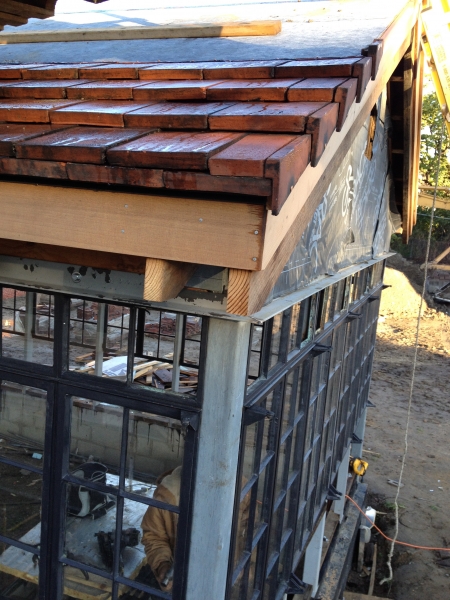It’s been another exciting week on the 600 block of West Alexandrine, with lifts hoisting materials to the rooftop cabins, continued earthmoving around the green alley, and crews working 50 feet in the air to install the top sections of our metal bay windows. Amid all of this buzz, a small crew from Esko Roofing began sifting and sorting through pallets of red clay roofing components, plotting how they’ll be reassembled for the roof of our greenhouse.
Typically the installation of a new roof the size of our greenhouse’s would simply involve selecting the color of the shingles, and work would be completed in a matter of days. If you’ve been following the work we’ve done at both the Green Garage and now the El Moore, you can imagine that the installation of our greenhouse roof took an altogether different path. I’ll start with a little recent history:
In the spring of 2103, we were in front of the Detroit Historic Commission seeking plan approval for the El Moore project. One of the properties on that month’s agenda was the home of Cleveland Gregory, who had recently purchased a large house on Boston Boulevard in the city’s Boston Edison historic district. The home had fallen into foreclosure and had been vacant for a number of years, and Mr. Gregory was committed to seeing it fully restored. And when I say fully, I mean fully: from complete plumbing and electrical systems to rebuilding plaster walls, rotted floors and yes, a complete rebuilding of the roof. On the day of the hearing, Mr. Gregory was seeking approval to remove what remained of the original clay tile roof so that a new roof could be installed.
After the meeting, we approached Mr. Gregory with the idea of reclaiming what remained of his tile roof, proposing that we package the tiles onto pallets and transport them to the El Moore with the intention of using them for the roof of our greenhouse. A roofer by trade, he was happy to see the tile reused and agreed.
This work was not simple: it involved Mr. Gregory’s two nephews carrying each tile through a third story attic window, down three flights of stairs, and into the backyard, where they were sorted by type, stacked on pallets, and wrapped in plastic. We then hired Boulevard and Trumbull Towing to load them onto a flatbed truck and transport them to our site, where they would sit for the next 18 months as we planned the greenhouse.
Once the tiles were delivered to our site, we were able to investigate them more closely and quickly learned more about their origin, based on a marking on the underside of each piece. Each tile is stamped with the name Ludowici, as well as a hand-applied date of production. Our tiles were created in two batches, on September 19, 1921 and October 22, 1922. They were in remarkably good shape for their age, but we were missing few pieces necessary to complete the reinstallation. Luckily, Ludowici still exists today in New Lexington, Ohio and they still produce the same tiles! Within two days of email communication with them, we had a color match and the missing components were shipped to our site.
Clay tile roofs like these are often referred to in the industry as “100 year roofs” due to their high quality and durability. This week these 92 year old tiles are being applied yet again to serve as protection for a new building, hopefully for another 100 years.


